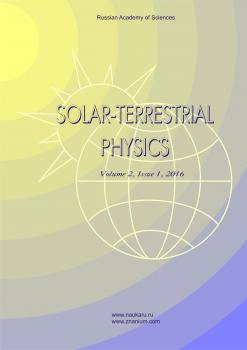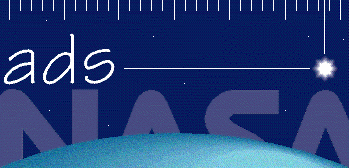from 01.01.2008 until now
Borok, Russian Federation
This paper deals with extreme conditions of the global magnetosphere disturbance: very quiet and greatly disturbed, and their relationship with interplanetary medium parameters. The degree of global magnetosphere disturbance was estimated from the monthly and annual number of magnetically quiet and magnetically disturbed days. The cyclic and seasonal distributions of magnetically quiet and disturbed days were compared, and their relationship with interplanetary medium parameters in solar cycles 20–24 was analyzed. Magnetically quiet days are shown to be mainly observed at the ascending phase of solar activity and during the winter solstice season. Magnetically disturbed days dominate at the descending phase of the solar cycle and during the equinox season. An anomalously large increase in the number of quiet days was found in solar cycle 24 as compared to previous cycles. It has been established that the cyclic variation in the annual number of quiet and disturbed days is determined by the behavior and magnitude of the speed, temperature, dynamic pressure of solar wind plasma and the interplanetary magnetic field modulus. The detected burst in the number of quiet days during the ascending phase of solar cycle 24 is assumed to reflect internal processes on the Sun and related changes in interplanetary medium parameters. The patterns of cyclical and seasonal variation in the number of magnetically quiet and disturbed days and their relationship with the solar wind parameters can be used to predict space weather.
magnetosphere, geomagnetic activity, space weather, solar activity cycles, magnetically quiet and magnetically disturbed days, solar wind parameters
1. Ahluwalia H.S. Ap time variations and interplanetary magnetic field intensity. J. Geophys. Res. 2000, vol. 105, no. A12, pp. 27,481-27,487. DOI:https://doi.org/10.1029/2000JA900124
2. Barkhatov N.A., Revunova E.A., Vinogradov A.B. Effect of orientation of the solar wind magnetic clouds on the seasonal variation of geomagnetic activity. Cosmic Res. 2014, vol. 52, no. 4, pp. 269-277. DOI:https://doi.org/10.1134/S0010952514040017.
3. Borovsky J.E., Denton M.H. Differences between CME-driven storms and CIR-driven storms. J. Geophys. Res. 2006, vol. 111, A07S08. DOI:https://doi.org/10.1029/2005JA011447.
4. Burlaga L.F., Sittler E., Mariani F., Schwenn R. Magnetic loop behind an interplanetary shock: Voyager, Helios, and IMP 8 observations. J. Geophys. Res. 1981, vol. 86, pp. 6673-6684.
5. Chu X., McPherron R.L., Hsu T.-S., Angelopoulos V. Solar cycle dependence of substorm occurrence and duration: Implications for onset. J. Geophys. Res: Space Phys. 2015, vol. 120, pp. 2808-2818. DOI:https://doi.org/10.1002/2015JA021104.
6. Cortie A.L. Sunspot and Terrestrial magnetic phenomena, 1898-1911. Mon. Not. Roy. Astron. Soc. 1912, vol. 73, pp. 52-60.
7. Despirak I.V., Lyubchich A.A., Kleimenova N.G. Solar Wind streams of different types and high-latitude substorms. Geomagnetism and Aeronomy. 2019, vol. 59, no. 1, pp. 1-6. DOI:https://doi.org/10.1134/S0016793219010055.
8. Gvishiani A.D., Soloviev A.A., Starostenko V.I., Sumaruk Y.P., Legostaeva O.V. A decrease in solar and geomagnetic activity from cycle 19 to cycle 24. Geomagnetism and Aeronomy. 2015, vol. 55, no. 3, pp. 299-306. DOI:https://doi.org/10.1134/S0016793215030093.
9. Holappa L., Mursula K., Asikainen T. A new method to estimate annual solar wind parameters and contributions of different solar wind structures to geomagnetic activity. J. Geophys. Res: Space Phys. 2014, vol. 119, pp. 9407-9418. DOI:https://doi.org/10.1002/2014JA020599.
10. Hutchinson J.A., Wright D.M., Milan S.E. Geomagnetic storms over the last solar cycle: A superposed epoch analysis. J. Geophys. Res. 2011, vol. 116, A09211. DOI:https://doi.org/10.1029/2011JA016463.
11. Kane R.P. The idea of space weather - a historical perspective. Adv. Space Res. 2006, vol. 37, pp. 1261-1264. DOI:https://doi.org/10.1016/j.asr.2006.01.014.
12. Katus R.M., Liemohn M.W., Ionides E.L., Ilie R., Welling D., Sarno-Smith L.K. Statistical analysis of the geomagnetic response to different solar wind drivers and the dependence on storm intensity. J. Geophys. Res: Space Phys. 2015, vol. 12, pp. 310-327. DOI:https://doi.org/10.1002/2014JA020712.
13. Loewe C.A., Prӧlss G.W. Classification and mean behavior of magnetic storms. J. Geophys. Res. 1997, vol. 102, no. A7, pp. 14209-14213. DOI:https://doi.org/10.1029/96JA04020.
14. Makarov G.A. Heliolatitude regularities of magnetically disturbed days with daily average geomagnetic index Dst<-100 nT. Solar-Terr. Phys. 2018, vol. 4, no. 3, pp. 20-23. DOI:https://doi.org/10.12737/stp-43201803.
15. McIntosh D.H. On the annual variation of magnetic disturbance. Philos. Trans. Roy. Soc. London. Ser. A. 1959, vol. 251, pp. 525-552.
16. McIntosh S.W., Leamon R.J., Dikpati M., et al. What the sudden death of solar cycles can tell us about the nature of the solar interior. Solar phys. 2019, vol. 294, no. 88. DOI:https://doi.org/10.1007/s11207-019-1474-y.
17. Newell P.T., Gjerloev J.W., Mitchell E.J. Space climate implications from substorm frequency. J. Geophys. Res: Space Phys. 2013, vol. 118, pp. 6254-6265. DOI: 10.1002/ jgra.50597.
18. Newell P.T., Liou K., Gjerloev J.W., Sotirelis T., Wing S., Mitchell E.J. Substorm probabilities are best predicted from solar wind speed. J. Atmos. Solar-Terr. Phys. 2016, vol. 146, pp. 28-37. DOI:https://doi.org/10.1016/j.jastp.2016.04.019.
19. Nusinov A.A., Rudneva N.M., Ginzburg E.A., Dremukhina L.A. Seasonal variations in statistical distributions of geomagnetic activity indices. Geomagnetism and Aeronomy. 2015, vol. 55, no. 4, pp. 493-498. DOI:https://doi.org/10.1134/S0016793215040106.
20. Obridko V.N., Kanonidi Kh.D., Mitrofanova T.A., Shelting B.D. Solar activity and geomagnetic disturbances. Geomagnetism and Aeronomy. 2013, vol. 53, no. 2, pp. 147-156. DOI:https://doi.org/10.1134/S0016793213010143.
21. Ouattara F., Amory-Mazaudier C., Menvielle M., Simon P., Legrand J.P. On the long term change in the geomagnetic activity during the 20th century. Ann. Geophys. 2009, vol. 27, pp. 2045-2051. DOI:https://doi.org/10.5194/angeo-27-2045-2009.
22. Papitashvili V.O., Papitashvili N.E., King J.H. Solar cycle effects in planetary geomagnetic activity: Analysis of 36-year long OMNI dataset. Geophys. Res. Lett. 2000, vol. 27, no. 17, pp. 2797-2800. DOI:https://doi.org/10.1029/2000GL000064.
23. Penn M.J., Livingston W. Long-term evolution of sunspot magnetic fields. Proc. IAU Symp. The Physics of Sun and Star Spots. 2010, vol. 273, pp. 126-133.
24. Reeves G., Morley S., Cunningham G. Long-term variations in solar wind velocity and radiation belt electrons. J. Geophys. Res: Space Phys. 2013, vol. 118, pp. 1040-1048. DOI:https://doi.org/10.1002/jgra.50126.
25. Russell C.T., McPherron R.L. Semiannual variation of geomagnetic activity. J. Geophys. Res. 1973, vol. 78, pp. 92-108.
26. Shevnin A.D. Quiet geomagnetic intervals as inferred from the Kp index. Geomagnetizm i aeronomiya [Geomagnetism and Aeronomy]. 2003, vol. 43, no. 2, pp. 210-214. (In Russian).
27. Tanskanen E. I., Hynönen R., Mursula K. Seasonal variation of high-latitude geomagnetic activity in individual years. J. Geophys. Res: Space Phys. 2017, vol. 122, pp. 10,058-10,071. DOI:https://doi.org/10.1002/2017JA024276.
28. Tsurutani B.T., Echer E., Gonzalez W.D. The solar and interplanetary causes of the recent minimum in geomagnetic activity (MGA23): a combination of midlatitude small coronal holes, low IMF Bz variances, low solar wind speeds and low solar magnetic fields. Ann. Geophys. 2011, vol. 29, pp. 839-849. DOI:https://doi.org/10.5194/angeo-29-839-2011.
29. Veselovskii I.S., Dmitriev A.V., Suvorova A.V. Average parameters of the solar wind and interplanetary magnetic field at the Earth’s orbit for the last three solar cycles. Solar System Research. 1998, vol. 32, no. 4, pp. 310-315.
30. Vijaya Lekshmi D., Balan N., Tulasi Ram S., Liu J.Y. Statistics of geomagnetic storms and ionospheric storms at low and mid latitudes in two solar cycles. J. Geophys. Res. 2011, vol. 116, A11328. DOI:https://doi.org/10.1029/2011JA017042.
31. Yermolaev Yu.I., Yermolaev M.Yu. Solar and interplanetary sources of geomagnetic storms: space weather aspects. Geofizicheskie protsessy i biosfera [Geophysical processes and biosphere]. 2009, vol. 8, no. 1, pp. 5-35. (In Russian).
32. Yermolaev Y.I., Lodkina I.G., Nikolaeva N.S., Yermolaev M.Y. Occurrence rate of extreme magnetic storms. J. Geophys. Res: Space Phys. 2013, vol. 118, pp. 4760-4765. DOI:https://doi.org/10.1002/jgra.50467.
33. Zhang J.-C., Liemohn M.W., Kozyra J.U., Thomsen M.F., Elliott H.A., Weygand J.M. A statistical comparison of solar wind sources of moderate and intense geomagnetic storms at solar minimum and maximum. J. Geophys. Res. 2006, vol. 111, vol. A01104. DOI:https://doi.org/10.1029/2005JA011065.
34. Zhang X.-Y., Moldwin M.B. The source, statistical properties, and geoeffectiveness of long-duration southward interplanetary magnetic field intervals. J. Geophys. Res: Space Phys. 2014, vol. 119, pp. 658-669. DOI: 10.1002/ 2013JA018937.
35. URL: http://swdcwww.kugi.kyoto-u.ac.jp/index.html (accessed January 30, 2019).
36. URL: http://www.wdcb.ru/stp/data/storms/mag-netic_ storms/ (accessed January 16, 2019).
37. URL: http://www.kakioka-jma.go.jp/obsdata/dataviewer/ (accessed January 16, 2019).
38. URL: http://omniweb.gsfc.nasa.gov/ow.html (accessed January 30, 2019).

















